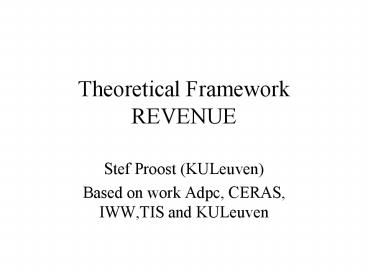Theoretical Framework REVENUE PowerPoint PPT Presentation
1 / 17
Title: Theoretical Framework REVENUE
1
Theoretical Framework REVENUE
- Stef Proost (KULeuven)
- Based on work Adpc, CERAS, IWW,TIS and KULeuven
2
Objectives
- Give theoretical guidelines on
- Pricing and investment rules
- The associated rules for using transport charges
revenues - Pass these guidelines under two forms to case
studies - Written guidelines
- Small model (molino)
3
Approach taken in Theory Work
Cost structure, pricing and deficits
MOLINO-model to compare alternative options in
the case studies
Public Finance aspects
Neo Classical theory
Infrastructure funds and Contract theory
EU wide orders of magnitude
Systems Dynamics model
4
Cost structure, pricing and deficits
- Theory
- The self-financing theorem
- The optimal user charges (Marginal External
Congestion Costs) finance the costs of
infrastructure if marginal cost of capacity
extension is constant and this is rather robust
result- - Empirical evidence
- For roads ok
- For Rail mixed evidence but optimal user charges
can go some way to cover infrastructure costs
5
Approach taken in Theory Work
Cost structure, pricing and deficits
MOLINO-model to compare alternative options in
the case studies
Public Finance aspects
Neo Classical theory
Infrastructure funds and Contract theory
EU wide orders of magnitude
Systems Dynamics model
6
Some conclusions on public finance aspects 1
- Cost of Investment depends on the way it is
financed because a Euro of public revenu comes
mostly from labour taxes and they have a high
efficiency cost this has 2 implications - The CBA ratio of an investment depends on the way
it is financed - The optimal use of revenues may very well be to
reduce existing labour taxes
7
Some conclusions on public finance aspects 2
- Integration of equity and efficiency
considerations in transport pricing and
in-investment studies is possible but requires to
know - Who uses transport infrastructure
- Who pays for the subsidies to fund the investment
8
Some conclusions on public finance aspects 3
- Multi-government problems
- Spillovers of benefits of investment projects
into other regions are not such a big problem if
user charging is possible - Risk of monopoly charging is there is limited
competition between routes or transport
alternatives - Vertical tax externalities may be important
handicap for investment and pricing projects - (gasoline taxes may go to the federal level and
limit the pricing options for lower government
levels)
9
Some conclusions on public finance aspects 4
- Political economy models can help to explain
- The excessive demand (lobbying) for specific
transport investments in some regions - Earmarking (dedicating revenues) not good in
theory, but may be a way to commit politicians to
not waste the money
10
Approach taken in Theory Work
Cost structure, pricing and deficits
MOLINO-model to compare alternative options in
the case studies
Public Finance aspects
Neo Classical theory
Infrastructure funds and Contract theory
EU wide orders of magnitude
Systems Dynamics model
11
Contracting and role of Investment agency 1
- The choice between public and private management
(and the balance between them) depends highly on
- divergence of objectives (externalities, market
power) - financial aspects (cost of public funds compared
to the risk premium leverage, ratings,...) - Experience with contrating out road, rail and air
can to some extent be translated into guidelines
and efficiency parameters contracting out can
generate an efficiency gain of say 5 to 20 in
some cases
12
Contracting and role of Investment agency 2
- Discussion of investment agency advantages
- independence credibility of commitments,
continuity of infrastructure development - skills in contract engineering
- reduction of information asymmetries may give
precious help whatever the precise definition of
the agency
13
Objectives of MOLINO 1
- Model to support implementation of theoretical
guidelines of Revenu-consortium - Designed to compute impacts (short to long term)
of alternative pricing, investment and revenu use
strategies - Implementable for all case studies
14
Realisation MOLINO
- Simple multi-purpose model in Mathematica
- Dimensions of model
- Any 2 competing modes
- Passenger transport (poor rich) and freight
transport (local, transit) - Role for operator and infrastructure manager
- Dynamics of infrastructure funds
- Reduced form coefficients for contract
efficiency, marginal cost of funds, equity - An illustrative example for an investment in a
tunnel in Antwerp was developed
15
The Key Features of MOLINO
16
- Economics is extremely useful as
17
- Economics is extremely useful as
- a form of employment for economists
(J.K.Galbraith)

